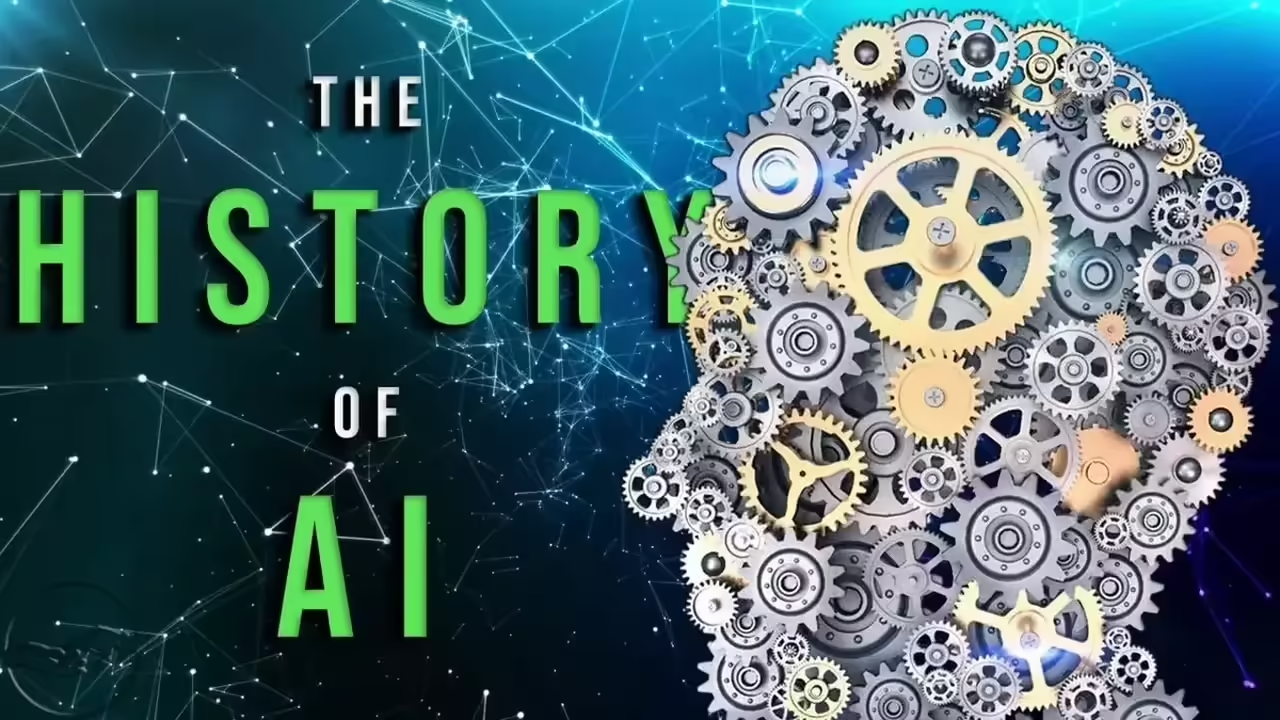
In the digital age in which we live, Artificial Intelligence (AI) has emerged as one of the most fascinating and transformative technologies of our time. From virtual assistants on our mobile devices to recommendation systems on streaming platforms to advanced medical applications, AI has infiltrated almost every aspect of our lives, driving breakthrough innovations and improving efficiency in a variety of fields. But what exactly is Artificial Intelligence and how has it evolved to become what it is today?
Defining Artificial Intelligence:
Artificial Intelligence refers to the ability of machines and computer systems to perform tasks that would normally require human intelligence. These tasks include learning, perception, reasoning, decision making and problem solving. AI seeks to simulate human cognitive processes through advanced mathematical algorithms and models, enabling machines to process data, learn from it, and make informed decisions.
History of Artificial Intelligence:
The history of Artificial Intelligence dates back to the 1950s, when pioneers in the field, such as Alan Turing and John McCarthy, laid the theoretical foundations for intelligent computing. Turing proposed the famous “Turing Test” as a way to assess the intelligence of a machine, while McCarthy organized the Dartmouth conference in 1956, where the term “Artificial Intelligence” was coined.
In the early years, researchers were excited about the prospect of machines being able to mimic human thinking. However, initial expectations exceeded the capabilities of the technology at the time, leading to a period known as “AI Winter” in the 1970s, where progress slowed and research funding became scarce.
The AI Renaissance:
In the late 1990s and early 2000s, AI experienced a significant resurgence thanks to advances in data processing, computational power, and the availability of large data sets. Machine learning, a branch of AI that allows machines to learn from experience without being explicitly programmed, became central to the field of Artificial Intelligence.
In addition to machine learning, AI also benefited from approaches such as natural language processing (NLP), which allowed machines to understand and communicate with humans in a more natural way, and computer vision, which gave them the ability to interpret and process images and videos.
Applications of Artificial Intelligence:
Artificial Intelligence has ceased to be mere speculation and has become a fundamental tool in a variety of fields. Some of the notable applications include:
Virtual assistants: Siri, Alexa and Google Assistant are examples of virtual assistants that use AI techniques to understand natural language and perform tasks such as answering questions and controlling connected devices.
Autonomous cars: AI is used to develop vehicles that can drive autonomously, using advanced sensors and algorithms to navigate safely.
Medicine and healthcare: AI is applied in medical diagnosis and prognosis, helping healthcare professionals to detect diseases and provide personalized treatments.
Finance: In the financial sector, AI is used for risk analysis, fraud detection and algorithmic trading.
Games: AI algorithms are used in games to create virtual opponents that can adapt to and challenge human players.
Challenges and Ethical Considerations:
While AI has shown amazing promise, it also faces significant challenges. Data privacy, algorithmic bias, security, and impact on employment are critical issues that require attention and regulation. It is essential that AI applications be ethical and equitable, protecting human rights and values.
The Beginnings of Artificial Intelligence
The beginnings of Artificial Intelligence (AI) date back to the mid-20th century, when early visionaries and scientists began to explore the idea of creating machines that could mimic or simulate human intelligence. These early steps laid the foundation for the development and evolution of AI in the decades that followed. Below, we will explore the most important milestones in the early days of Artificial Intelligence:
Alan Turing and the Turing Machine (1936):
Alan Turing, a British mathematician, presented in 1936 the concept of a theoretical machine, known as the “Turing Machine”. This machine was a mathematical model that showed how a mechanical device could follow a series of instructions to perform any computable task. Turing also proposed what is now known as the “Turing Test,” a test designed to assess whether a machine can exhibit intelligent behavior that is indistinguishable from human behavior.
Early work in AI (1940s and 1950s):
In the 1940s and 1950s, researchers and scientists began to take an interest in the possibility of creating intelligent machines. One of the first notable projects was the “ENIAC” (Electronic Numerical Integrator and Computer), one of the first general electronic computers. Although the ENIAC was not an AI machine per se, its development contributed to the growth of the idea of machines with cognitive abilities.
Dartmouth Conference (1956):
In the summer of 1956, John McCarthy, considered the “father of AI,” organized the Dartmouth Conference. During this conference, McCarthy and other researchers formally proposed the term “Artificial Intelligence” to describe the emerging field that sought to develop machines capable of thinking, learning and problem solving.
Early achievements in AI:
In the 1950s, significant advances were made in the field of AI. Allen Newell and Herbert A. Simon developed the Logic Theorist, a computer program that could prove mathematical theorems. They also developed the “General Problem Solver” (GPS), a program capable of solving problems by applying logical rules.
Perceptron and the winter of AI:
In the 1960s, psychologist and computer scientist Frank Rosenblatt worked on the development of the “Perceptron,” an artificial neural network model inspired by the workings of the human brain. Although the Perceptron showed promising results in classification tasks, its limitations and criticism by Minsky and Papert in their book “Perceptrons” (1969) led to a period known as “AI Winter,” where advances in the field stalled due to a lack of technological breakthroughs and theoretical challenges.
AI Renaissance:
In the late 1980s and early 1990s, AI experienced a significant resurgence, driven by advances in computing power and the development of more sophisticated algorithms. Machine learning, especially with the rise of neural networks and the processing of large data sets, revitalized the field and laid the foundation for modern AI.
The Decade of Expectations: The Golden Age of AI
The Decade of Expectations, also known as the “Golden Age of AI,” refers to a period of time spanning roughly from the early 21st century to the present day. During this stage, Artificial Intelligence has experienced explosive growth and significant advances in a variety of areas, driving profound changes in society and transforming the way we live and work.
Key factors of the Golden Age of AI:
Advances in Machine Learning: One of the main catalysts of this era has been the rapid advancement in machine learning, especially in the field of deep learning. Deep neural networks and deep learning algorithms have demonstrated an unprecedented ability to process large amounts of data and extract complex patterns, allowing machines to learn and improve their own performance over time.
Big Data: The increasing availability and access to vast amounts of data have been central to the success of modern AI. With the rise of the internet and the digitization of information, machines now have access to massive data sets that allow them to train and refine their models with unprecedented accuracy and efficiency.
Computational Power: The increase in computer processing power has been a key enabler for AI. Advances in processor technology and the use of graphics processing units (GPUs) have enabled complex computations to be performed in parallel, significantly accelerating the time required to train and run AI models.
Enterprise Applications: Industry has recognized the potential of AI to improve efficiency and decision making. Companies in various sectors, such as healthcare, e-commerce, logistics, automotive, marketing and banking, among others, have actively adopted AI solutions to gain competitive advantages and offer more personalized products and services.
Research and Investment: The scientific community and industry have shown great interest in AI during this decade, leading to significant investment in research and development. Large technology companies, as well as startups, have dedicated substantial resources to advance the field of AI and bring new ideas to market.
Virtual Assistants and Consumer Applications: The emergence of virtual assistants, such as Siri, Alexa and Google Assistant, has brought AI closer to the average user and made AI applications more accessible to the general public. Voice recognition, natural language processing and content recommendation applications on entertainment platforms are just a few examples of how AI has impacted our daily lives.
Challenges and Considerations:
While the Golden Age of AI has brought impressive advances, it has also raised significant challenges and considerations. Some concerns include data privacy, ethics in automated decision making, algorithmic bias, and impact on employment, among others.
The Winter of Artificial Intelligence: Challenges and Disappointments
The “Artificial Intelligence Winter” refers to a historical period in the development of AI, characterized by challenges and disappointments that led to a decline in investment, interest and progress in the field. This period was divided into two distinct moments:
First AI Winter (1974-1980):
The first “AI Winter” occurred in the 1970s, after an initial period of great enthusiasm and expectations about the potential of AI. Technological advances failed to meet the high expectations and ambitions held at the time, resulting in widespread disillusionment with AI as a field of research and development.
Factors contributing to the First AI Winter:
(a) Technological limitations: The technology of the time did not have sufficient processing power to handle the complex computations required for machine learning and other AI approaches.
b) Lack of adequate data and training sets: Data availability was limited and therefore hindered the development and training of effective AI models.
c) Unrealistic expectations: Initial expectations of AI capabilities were very high and did not match the reality of the technological limitations of the time.
d) Budget cuts: Lack of tangible results led to cuts in government funding and AI research.
Second AI Winter (1987-1993):
The second “AI Winter” occurred in the 1980s and early 1990s. Despite some advances in technology and research, the field again encountered significant challenges and limitations.
Factors that contributed to the Second AI Winter:
(a) Unmet Expectations: Although there were some notable advances, many of the initial promises of AI had yet to materialize, leading to a sense of disillusionment and skepticism.
b) Limited approaches: Traditional AI approaches, such as the use of logical rules and expert systems, proved insufficient to address more complex and realistic problems.
c) Complexity of the problem: It became evident that replicating human intelligence in its entirety was a much more complex and challenging goal than initially thought.
d) Limited resources: Financial and technological resources dedicated to AI were reduced, which affected the ability of researchers to advance the field.
Overcoming Winter:
Despite the challenges and disappointments, AI did not completely disappear during these periods. Instead, the AI Winter led to greater reflection and focus on research into more realistic approaches and practical applications. Over time, advances in computing power, the availability of large data sets, and the development of new approaches, such as deep learning, revived interest and progress in AI, giving way to the “Golden Age of AI” that we have experienced in recent decades.







